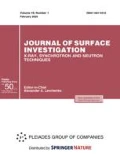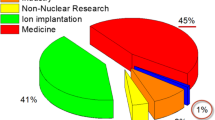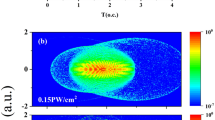Abstract
A method for controlling the focusing of an ionizing-radiation beam, for example, a beam of charged particles, is proposed. Ionization is one of the most widely used radiation-detection methods. The effect of the recombination of charge carriers in the working substance of the detector, accompanying ionization, is usually considered as undesirable, which reduces the accuracy of measuring the radiation parameters. However, this effect can be useful and be the basis of a method for determining the maximum degree of focusing of a beam of particles or ionizing radiation. At a fixed value of the total beam current (ionizing-radiation flux), the maximum focusing is determined from the minimum value of the ionization current in a wide-aperture ionization chamber, which is used as a detector. The signal of the ionization chamber changes during focusing even at a fixed value of the beam current due to the dependence of the intensity of the recombination of charge carriers in the working substance of the chamber on their bulk density. The bulk density of carriers, in turn, is proportional to the distribution density of particles of the ionizing-radiation beam in the volume of the working medium of the ionization chamber.



Similar content being viewed by others
REFERENCES
Accelerators and Beams Tools of Discovery and Innovation (Division of Physics of Beams, Am. Phys. Soc., 2013). http://www.aps.org/units/dpb/upload/accel_beams_ 2013.pdf.
I. Y. Vladimirov, B. S. Ishkhanov, L. Y. Ovchinnikova, et al., Moscow Univ. Phys. Bull. (Engl. Transl.) 71, 245 (2016). https://doi.org/10.3103/S0027134916030139
V. I. Pavlenko, R. N. Yastrebinskii, O. D. Edamenko, and D. G. Tarasov, Vopr. At. Nauki Tekh., Ser.: Fiz. Radiats. Povrezhdenii Radiats. Materialoved., No. 1, 129 (2010).
M. F. Vorogushin, V. A. Glukhikh, G. Sh. Manukyan, D. A. Karpov, M. P. Svin’in, V. I. Engel’ko, and B. P. Yatsenko, Vopr. At. Nauki Tekh., Ser.: Fiz. Radiats. Povrezhdenii Radiats. Materialoved., No. 3, 101 (2002).
M. Vretenar, Accelerators for Medicine. Academic Training Lecture Regular Programme (CERN, June 2018). https://indico.cern.ch/event/722936/
A. V. Grizlov, V. N. Iliin, S. V. Lamonov, et al., in Proc. XI Int. Conf. on Charged Particle Accelerators Applied in Medicine and Industry (St. Petersburg, 2005), p. 132.
A. S. Alimov, E. A. Alimov, A. N. Kamanin, et al., in Proc. RuPAC 2008 (Zvenigorod, 2008), p. 267. http://www.researchgate.net/publication/238769202_ Beam_parameters_measurement_of_technological_ 10_MEV_linac. Accessed October 11, 2021.
A. P. Chernyaev, M. A. Kolyvanova, and P. Yu. Borshchegovskaya, Moscow Univ. Phys. Bull. (Engl. Transl.) 70, 457 (2015). https://doi.org/10.3103/S0027134915060090
V. I. Boiko, A. N. Valyae, and A. D. Pogrebnyak, Phys.—Usp. 42, 1139 (1999). https://doi.org/10.1070/PU1999v042n11ABEH000471
R. A. Salimov, Phys.—Usp. 43, 189 (2000). https://doi.org/10.1070/1070pu2000v043n02ABEH000671
A. G. Gurin, E. A. Kornilov, and R. S. Lozhkin, Elektrotekh. Elektromekh., No. 4, 47 (2013).
M. R. Cleland, in Industrial Applications of Electron Accelerators (CERN Accelerator School, Zeegse, 2005), p. 383.
S. Machi, in Proc. Int. Topical Meeting on Nuclear Research Applications and Utilization of Accelerators (Vienne, 2009), SM/EB-04.
D. H. Wilkinson, Ionization Chambers and Counters (Cambridge Univ. Press, New York, 1950).
Y. I. Bychkow, Y. D. Korolevn, and A. P. Khuzeev, Sov. Tech. Phys. 19, 140 (1974).
A. V. Eletskii and B. M. Smirnov, Sov. Phys. Usp. 25, 13 (1982). https://doi.org/10.1070/PU1982v025n01ABEH004494
R. Hooke and T. A. Jeeves, J. Assoc. Comput. Mach. 8, 212 (1961).
J. A. Nelder and R. Mead, Comput. J. 7, 308 (1965).
S. V. Blazhevich and V. A. Stratienko, USSR Patent No. 1 667 519, 1991.
Author information
Authors and Affiliations
Corresponding author
Ethics declarations
The authors declare that they have no conflicts of interest.
Rights and permissions
About this article
Cite this article
Blazhevich, S.V., Noskov, A.V. Ionization-Recombination Process as a Means of Indicating the Degree of Focusing of a Beam of Charged Particles or Ionizing Radiation. J. Surf. Investig. 16, 503–506 (2022). https://doi.org/10.1134/S1027451022030235
Received:
Revised:
Accepted:
Published:
Issue Date:
DOI: https://doi.org/10.1134/S1027451022030235




